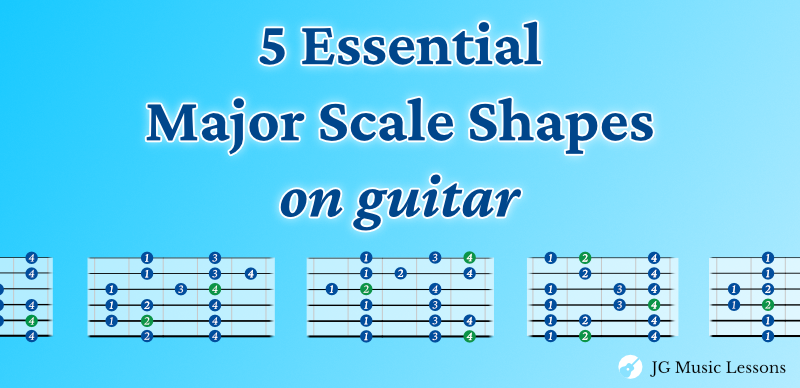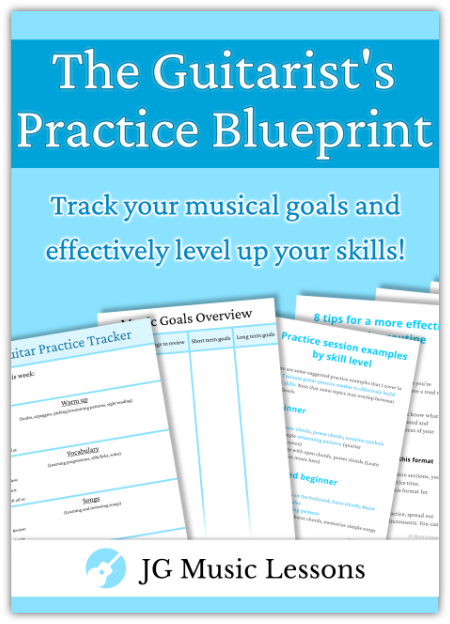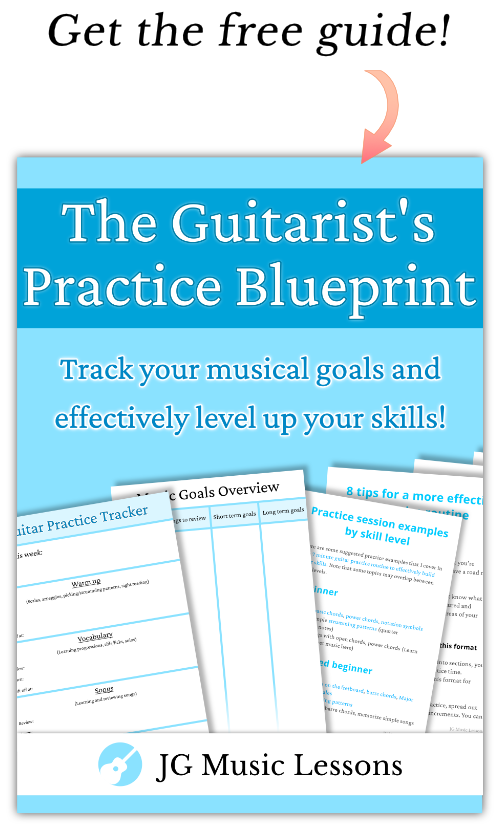Scales are a fundamental part of music, forming the foundation for melodies, riffs, and solos. While there are many scales worth learning, the Major scale stands out as one of the most essential for guitarists.
Although you can play the Major scale in a single position, the same notes can be found all over the fretboard. To truly master it, you’ll need to learn how to navigate these different positions. That’s where the five essential Major scale shapes come in!
By learning these shapes, you’ll connect the notes on the fretboard more fluidly, gain flexibility in your playing, and unlock new creative possibilities beyond a single position.
In this lesson, we’ll break down the music theory behind the Major scale, explore examples in different keys, and then dive into the five scale shapes every guitarist should know. Let’s get started!
*Free for Pro Members
Major scale theory
The Major scale consists of seven notes, each separated by a specific pattern of whole and half steps. The formula follows this sequence: whole, whole, half, whole, whole, whole, half (W-W-H-W-W-W-H).
For example, the C Major scale follows this pattern with the notes: C, D, E, F, G, A, and B (which shares the same notes as the A minor scale).
Refer to the chart below for a visual breakdown of this formula.
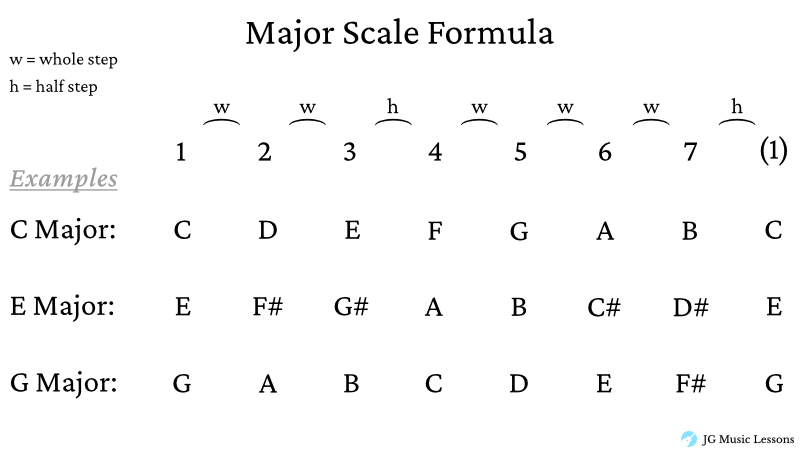
You can also understand the Major scale by thinking of its notes as intervals relative to the root note. These intervals are: unison (root), major 2nd, major 3rd, perfect 4th, perfect 5th, major 6th, and major 7th.
Another useful way to learn Major scales is by memorizing key signatures, which indicate the sharps or flats in each key. This approach helps you quickly identify the notes in any Major scale.
Major scale examples
Below are some different Major scales using the whole and half step formula in music notation with guitar tabs. If needed, check this link for more on how to read guitar notation symbols.
These examples show you the scales in one octave but later in this lesson, we’ll explore how to extend them beyond one octave.
C Major scale

E Major scale

This other lesson covers all of the shapes for the E Major scale.
G Major scale

This other lesson covers all of the shapes for the G Major scale.
Major scale chart in all keys
Before we move on, this chart shows you the notes for the Major scale starting on every root note.
| Major scale | 1 | 2 | 3 | 4 | 5 | 6 | 7 |
|---|---|---|---|---|---|---|---|
| C Major scale | C | D | E | F | G | A | B |
| D Major scale | D | E | F# | G | A | B | C# |
| E Major scale | E | F# | G# | A | B | C# | D# |
| F Major scale | F | G | A | Bb | C | D | E |
| G Major scale | G | A | B | C | D | E | F# |
| A Major scale | A | B | C# | D | E | F# | G# |
| B Major scale | B | C# | D# | E | F# | G# | A# |
| Db Major scale | Db | Eb | F | Gb | Ab | Bb | C |
| Eb Major scale | Eb | F | G | Ab | Bb | C | D |
| Gb Major scale | Gb | Ab | Bb | B | Db | Eb | F |
| Ab Major scale | Ab | Bb | C | Db | Eb | F | G |
| Bb Major scale | Bb | C | D | Eb | F | G | A |
Now, let’s start learning the 5 scale shapes throughout the guitar fretboard!
5 Major scale shapes on guitar
In this section, we’ll explore different Major scale shapes across the guitar fretboard. Each shape is shown with music notation and guitar tabs in the key of C Major, but you can apply these same patterns to any Major scale.
Afterward, you’ll see all 5 shapes connected on the fretboard in one chart.
How to read the scale charts
For the charts below:
- The left side shows the scale notes, while the right side indicates the suggested fingerings.
- The lowest horizontal line represents the thickest string (low E), and the top horizontal line represents the thinnest string (high E).
- Green circles indicate the root notes of the Major scale, while blue circles represent the other scale notes.
- Circles to the left of the chart indicate open strings.
If needed, check this link for more on how to read guitar notation symbols.
Major scale shape 1

For the notation below, the numbers above the notes suggest what fingers to use for your fretting hand.

Major scale shape 1 (all fretted notes)
If your guitar is suitable to play past the 12th fret, you can also play shape 1 like this:


Major scale shape 2


Major scale shape 3


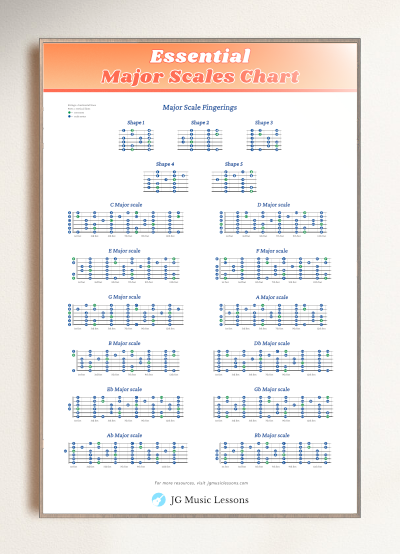
Major scale shape 4


Major scale shape 5


One thing to highlight about using these shapes is that whenever you have scales that use notes with open strings, you have to rearrange your fingers to play the shape. For example, if the shape uses the fingering 1, 3, and 4 on one string, you can play (open string), 1 and 3 instead.
While you’ll need to adjust some fingerings when open strings are involved, once you move to the next shape where all the notes are fretted, you’ll return to the original shapes we covered.
Major scale shapes connected on guitar
To show you how the Major scale shapes connect, here are all of the C Major scale notes across the guitar fretboard below.

You can also check out this other lesson to learn the C minor scale on guitar.
*Free for Pro Members
3 Tips for Memorizing the Major Scale shapes
1. Master one shape at a time
Start by learning the shape that feels most comfortable to you. Focus on getting the shape under your fingers to the point where you can play it without looking at the chart. Use this shape as a foundation to learn the other shapes around it.
2. Look for repeating fingering patterns
Identify patterns where the same fingering occurs across strings.
Quick tip: The notes on the 1st and 6th strings will always follow the same pattern.
For example, in shape 4, the 1st, 5th, and 6th strings follow a 1, 2, and 4 finger pattern, while the 3rd and 4th strings follow a 1, 3, and 4 pattern.
Recognizing these repeating patterns helps you build a mental map of each scale shape.
3. Connect shapes on the fretboard
Once you’ve mastered one scale shape, learn the shape before or after it to see how the notes connect across the fretboard. Focus on mastering each shape individually, without needing to look at the chart. Breaking down the shapes this way makes the learning process more manageable before moving on to the next shape.
Major scale across one string
Another way to practice scales is by playing them horizontally—meaning along a single string. While this isn’t a typical way to play scales, it’s a great method to check if you know all the notes in the scale you’re working on. Start by playing the notes consecutively on one string, moving from lower to higher notes.
Once you’ve played the scale in one direction (low to high), reverse the order and play it from high to low.
For example, if you’re learning the C Major scale, you would play these notes on the 6th string:

Improvising with the Major scale
Once you’re comfortable with the Major scale shapes, try creating melodies or musical phrases using the scale notes. The goal is to move beyond mechanical playing and start making music with it.
A great way to start is by humming or singing a short melody, then finding those notes on your instrument. This helps you learn to play what you want to hear—an essential step in improvisation. For more on this, check out our post on developing ear training.
You can also take a short melody or phrase and try shifting it to another key. You know you have a scale down when you can play it in any key and anywhere on the fretboard.
To improve your timing with scales, try practicing with a metronome (here’s a free metronome on our site) or with backing tracks. You can also experiment with different patterns and sequences, which I cover in this lesson on how to practice scales.
Relative minor scales
Did you know that by learning the Major scale you also end up learning the minor scale as well? If you were to start and end on the 6th degree of the Major scale, you’re also playing the relative minor scale. For example, the C Major scale and A minor scale are related because they share the same set of notes.
The whole and half-step formula shifts slightly, and it looks like this:

Backing Track 🎶
Practice the C Major scale by playing along with the backing track below.
🎵 Buy the track here or enjoy access to full audio tracks as a Pro Member! ✨
Wrapping up
Learning the Major scale shapes will deepen your understanding of the guitar, allowing you to play the same set of notes across the entire fretboard. While it’s easy to stay within your comfort zone, mastering these shapes will challenge you to approach the instrument with a fresh perspective.
Also, these scale shapes will boost your confidence in choosing the right notes when playing melodies or improvising. They’ll help you create musical ideas more naturally and play comfortably across the fretboard.
For more practice tips, check out this guide on how to practice scales on guitar.
After learning the Major scale, explore closely related scales like the pentatonic scale or blues scale. You can also dive into the Major scale modes and their related emotions here, or check out the specific modes below:
We hope this guide helps you apply these concepts to your playing and take your skills to the next level!
📘 Get the free guitar practice guide here!
All the best,
JG Music Lessons
Start Playing Better, Faster
by becoming a Pro Member! ✨
Transform your playing by enjoying benefits such as:
• 📙 Exclusive Lesson PDFs and Ebooks
Get access to a growing library of clear, downloadable resources—save time and skip the clutter.
• 🎼 Full Song Lessons
Break down your favorite songs step by step, and play them with confidence.
• 🚫 Ad-Free Learning
Focus better with a distraction-free environment.
• 🎁 Store Discounts
Save 50% off on all song PDFs, charts, audio tracks, bundles, and design printables.
• 💬 Member Support
Got questions? We’ve got your back, helping you stay on track!
👉 Join Here!
Level up with the FREE guitar practice guide and effectively improve your playing! 🎸
Get it sent to your email!

